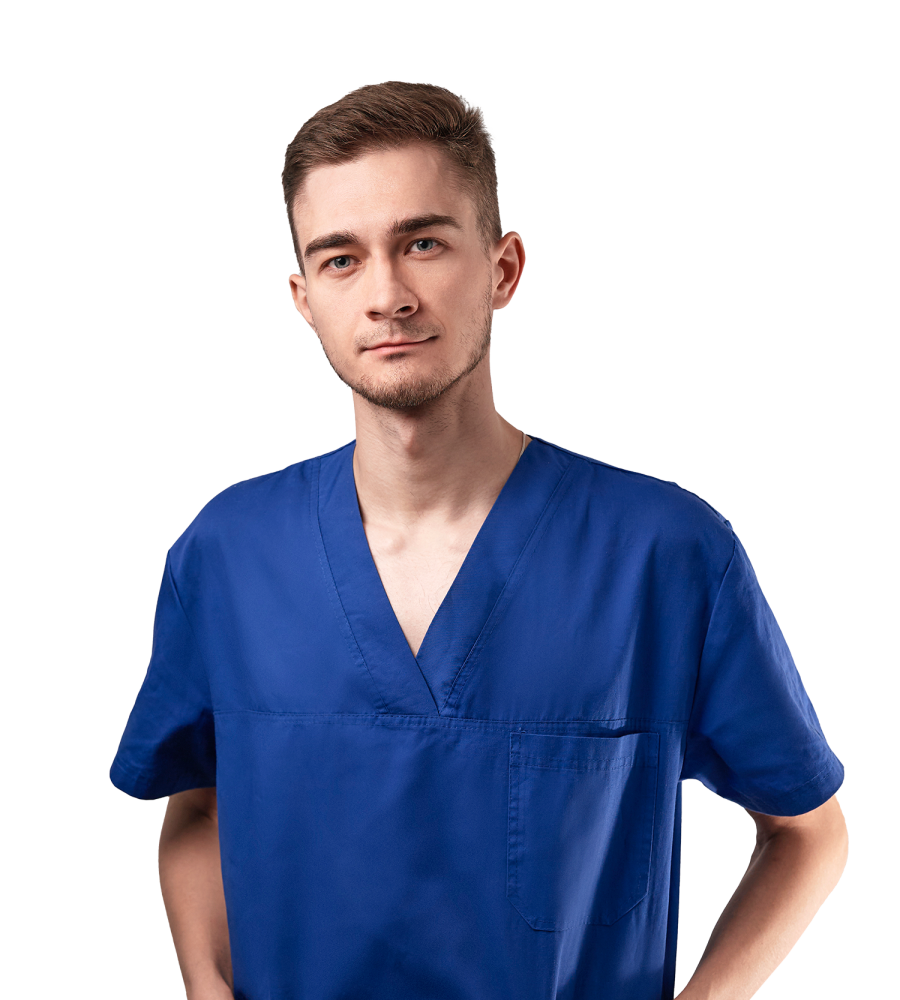Surgical removal of lipoma in Kharkov
Список выбранных услуг
Для добавления услуг с других отделений нужно закончить текущую запись.
A wen on the body (lipoma) appears in men and women mainly after 40 years. The neoplasm can be localized on the head, neck, shoulders, back and abdomen, less often on the arms and hips. Lipomas cause not only aesthetic discomfort, but also painful sensations, if growing, squeeze nerve endings in the skin. In addition, with mechanical damage to the wen, an infection can penetrate into it and cause inflammation of the tissues, therefore it is better to perform a surgical removal of the lipoma.
What is a lipoma and is it dangerous?
Lipoma is a benign formation that develops in the subcutaneous tissue. It is an accumulation of fat enclosed in a connective tissue capsule. Visually, a lipoma looks like a semicircular convex "bump" under the skin. It is soft to the touch, agile, and generally painless. The size of a benign tumor usually does not exceed 3-4 cm in diameter, but sometimes it can grow up to 15 cm in diameter or more. Lipoma grows very slowly over several years.
Lipoma is not prone to degeneration into a malignant tumor, so it is not dangerous to health. But it is important to make sure that this is not liposarcoma, which can degenerate into cancer. If any neoplasm of the skin appears, you need to consult a doctor and carry out a diagnosis.
There are several types of subcutaneous wen:
- perineural lipoma grows around the nerves;
- lumbosacral lipoma occurs near the vertebrae or the spinal canal;
- muscle lipoma grows through muscle fibers;
- vaginal lipoma occurs most often on the anterior wall of the vagina.
In addition to the usual lipoma, consisting mainly of fat, there are the following types of wen:
- fibrolipoma - contains fat and fibrous tissue;
- myolipoma - consists of fat and muscle cells;
- angiolipoma is infused with small blood vessels;
- myelolipoma - in addition to fat, it contains red bone marrow cells. Myelolipoma affects the adrenal glands and is rare.
The exact causes of wen occurrence have not yet been scientifically established. But the main factors that increase the risk of developing lipoma include:
- genetic predisposition;
- age-related changes;
- impaired fat metabolism (lack of enzymes responsible for fat splitting);
- pathology of the liver and pancreas;
- trauma to the skin and subcutaneous tissue;
- pituitary gland diseases;
- decreased thyroid function (hypothyroidism).
Subcutaneous lipomas are easily diagnosed during visual examination and palpation (hands-on). Lipomas inside the body can be detected using the following diagnostic tests:
- ultrasound of soft tissues and internal organs;
- MRI (magnetic resonance imaging);
- radiography.
Also, a patient may be referred to biopsy of tumor tissue if the doctor has doubts about its benign nature. The study involves taking a piece of tissue for further examination under a microscope.
Can lipomas be removed?
Lipoma removal is indicated if it:
- causes aesthetic and physical discomfort;
- is often injured;
- has changed color or consistency;
- increases in size;
- compresses the nerves or causes poor circulation in the part of the body where it is located.
If the lipoma is small and does not cause complaints, it may not be removed. In any case, before deciding on the removal of a wen on the body, you need to consult a surgeon. The doctor will conduct examination, give a referral for diagnostic tests and, based on their results, decide on the procedure advisability.
The only effective way to remove adipose tissue is surgery, since no drugs and traditional medicine can affect the reduction of adipose tissue. Lipoma removal is performed during upfront surgery. Local or intravenous anesthesia is used for pain relief. A doctor makes a small incision at the location of lipoma, removes the tumor and applies a cosmetic suture.
During the lipoma excision, the surrounding healthy tissue is not affected, and a barely noticeable scar remains at the incision site. The risk of neoplasm recurrence after surgical removal of the wen is reduced to zero. At the end of the operation, a patient is transferred to the inpatient ward, where he stays from several hours to 1 day, and then is discharged from the hospital.
Rehabilitation period after lipoma removal
After the operation for lipoma removal, a patient must regularly treat the stitches with antiseptic solution, change the dressing and prevent it from getting wet. After the stitches are removed (7-8 days), patient can discuss with your doctor the possibility of using ointments to heal scars, if the need arises.
It takes about 10-14 days to fully recover from lipoma removal. During this period, a patient is not recommended to visit the bathhouse, sauna, and also play sports.
You can make appointment for a consultation by surgeon regarding the surgical removal of lipoma in Kharkov at the medical center “ON Clinic Kharkov”. Call the specified phone number or leave a request on the website at any convenient time.
A wen on the body (lipoma) appears in men and women mainly after 40 years. The neoplasm can be localized on the head, neck, shoulders, back and abdomen, less often on the arms and hips. Lipomas cause not only aesthetic discomfort, but also painful sensations, if growing, squeeze nerve endings in the skin. In addition, with mechanical damage to the wen, an infection can penetrate into it and cause inflammation of the tissues, therefore it is better to perform a surgical removal of the lipoma.
What is a lipoma and is it dangerous?
Lipoma is a benign formation that develops in the subcutaneous tissue. It is an accumulation of fat enclosed in a connective tissue capsule. Visually, a lipoma looks like a semicircular convex "bump" under the skin. It is soft to the touch, agile, and generally painless. The size of a benign tumor usually does not exceed 3-4 cm in diameter, but sometimes it can grow up to 15 cm in diameter or more. Lipoma grows very slowly over several years.
Lipoma is not prone to degeneration into a malignant tumor, so it is not dangerous to health. But it is important to make sure that this is not liposarcoma, which can degenerate into cancer. If any neoplasm of the skin appears, you need to consult a doctor and carry out a diagnosis.
There are several types of subcutaneous wen:
- perineural lipoma grows around the nerves;
- lumbosacral lipoma occurs near the vertebrae or the spinal canal;
- muscle lipoma grows through muscle fibers;
- vaginal lipoma occurs most often on the anterior wall of the vagina.
In addition to the usual lipoma, consisting mainly of fat, there are the following types of wen:
- fibrolipoma - contains fat and fibrous tissue;
- myolipoma - consists of fat and muscle cells;
- angiolipoma is infused with small blood vessels;
- myelolipoma - in addition to fat, it contains red bone marrow cells. Myelolipoma affects the adrenal glands and is rare.
The exact causes of wen occurrence have not yet been scientifically established. But the main factors that increase the risk of developing lipoma include:
- genetic predisposition;
- age-related changes;
- impaired fat metabolism (lack of enzymes responsible for fat splitting);
- pathology of the liver and pancreas;
- trauma to the skin and subcutaneous tissue;
- pituitary gland diseases;
- decreased thyroid function (hypothyroidism).
Subcutaneous lipomas are easily diagnosed during visual examination and palpation (hands-on). Lipomas inside the body can be detected using the following diagnostic tests:
- ultrasound of soft tissues and internal organs;
- MRI (magnetic resonance imaging);
- radiography.
Also, a patient may be referred to biopsy of tumor tissue if the doctor has doubts about its benign nature. The study involves taking a piece of tissue for further examination under a microscope.
Can lipomas be removed?
Lipoma removal is indicated if it:
- causes aesthetic and physical discomfort;
- is often injured;
- has changed color or consistency;
- increases in size;
- compresses the nerves or causes poor circulation in the part of the body where it is located.
If the lipoma is small and does not cause complaints, it may not be removed. In any case, before deciding on the removal of a wen on the body, you need to consult a surgeon. The doctor will conduct examination, give a referral for diagnostic tests and, based on their results, decide on the procedure advisability.
The only effective way to remove adipose tissue is surgery, since no drugs and traditional medicine can affect the reduction of adipose tissue. Lipoma removal is performed during upfront surgery. Local or intravenous anesthesia is used for pain relief. A doctor makes a small incision at the location of lipoma, removes the tumor and applies a cosmetic suture.
During the lipoma excision, the surrounding healthy tissue is not affected, and a barely noticeable scar remains at the incision site. The risk of neoplasm recurrence after surgical removal of the wen is reduced to zero. At the end of the operation, a patient is transferred to the inpatient ward, where he stays from several hours to 1 day, and then is discharged from the hospital.
Rehabilitation period after lipoma removal
After the operation for lipoma removal, a patient must regularly treat the stitches with antiseptic solution, change the dressing and prevent it from getting wet. After the stitches are removed (7-8 days), patient can discuss with your doctor the possibility of using ointments to heal scars, if the need arises.
It takes about 10-14 days to fully recover from lipoma removal. During this period, a patient is not recommended to visit the bathhouse, sauna, and also play sports.
You can make appointment for a consultation by surgeon regarding the surgical removal of lipoma in Kharkov at the medical center “ON Clinic Kharkov”. Call the specified phone number or leave a request on the website at any convenient time.
| Название | Цена |
| 5000 uah | |
| 600 uah | |
| 850 uah | |
| 5500 uah | |
| 4500 uah | |
| 280 uah | |
| 2075 uah | |
| Consultation of an oncogynecologist | 700 uah |
| Consultation with a surgeon | 600 uah |
| Consultation with a surgeon-endocrinologist | 525 uah |
| Consultation with an oncosurgeon | 600 uah |
| Consultation with an operating obstetrician-gynecologist | 500 uah |
| Consultation with an operating surgeon | 500 uah |
| Consultation with an operating urologist | 550 uah |
| Endocrinology surgeon consultation | 600 uah |
| Home call to a surgeon | 1800 uah |
| ONLINE Consultation with a gynecological oncologist | 700 uah |
| ONLINE Consultation with a surgeon | 600 uah |
| ONLINE Consultation with an oncosurgeon | 600 uah |
| ONLINE Consultation with an surgeon-endocrinologist | 525 uah |
| ONLINE Thoracic Surgeon Consultation | 600 uah |
| Thoracic surgeon consultation | 500 uah |
The cost of appointments surgeon in Kharkiv
Другие услуги Surgery в Kharkiv
Список выбранных услуг
Для добавления услуг с других отделений нужно закончить текущую запись.















